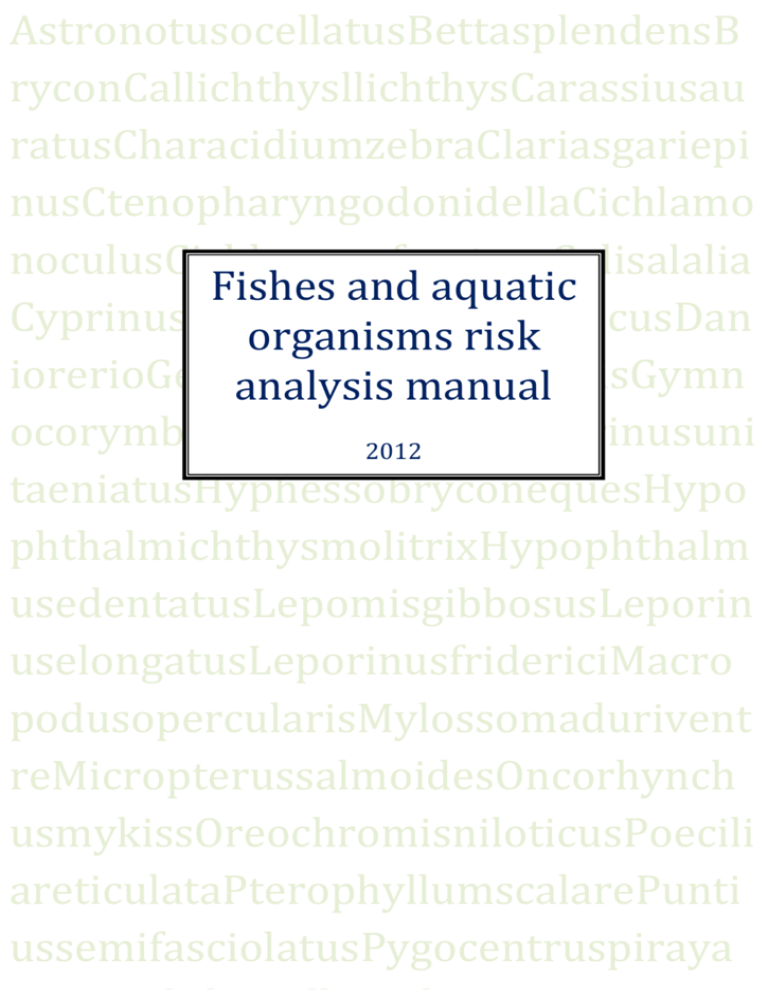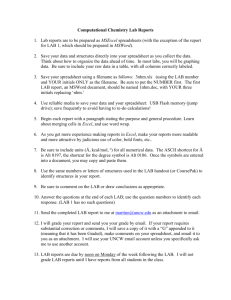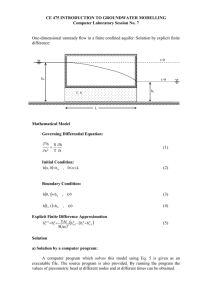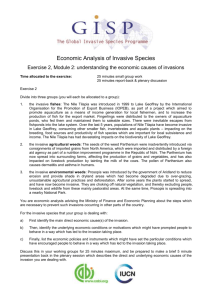Fishes User Manual
advertisement

AstronotusocellatusBettasplendensB ryconCallichthysllichthysCarassiusau ratusCharacidiumzebraClariasgariepi nusCtenopharyngodonidellaCichlamo noculusCichlasomafacetumColisalalia Fishes and aquatic CyprinuscarpioDaniomalabaricusDan organisms risk iorerioGeophagussurinamensisGymn analysis manual ocorymbusternetziHoplerythrinusuni 2012 taeniatusHyphessobryconequesHypo phthalmichthysmolitrixHypophthalm usedentatusLepomisgibbosusLeporin uselongatusLeporinusfridericiMacro podusopercularisMylossomadurivent reMicropterussalmoidesOncorhynch usmykissOreochromisniloticusPoecili areticulataPterophyllumscalarePunti ussemifasciolatusPygocentruspiraya 1 2 Fishes and aquatic organisms risk analysis manual WRITTEN BY: 3 SUMMARY Introduction ......................................................................................... 1 Overview ............................................................................................. 2 General concepts .............................................................................. 2 Risk analysis for non-native species ..................................................... 3 How the system is organized .................................................................. 5 System requirements......................................................................... 5 How the system functions (first steps) ................................................ 5 Risk assessment results ..................................................................... 6 Limitations and classification .............................................................. 8 Calculating the level of risk .................................................................. 10 Final remarks ..................................................................................... 11 Contacts and credits ............................................................................ 11 1 INTRODUCTION Risk analysis protocols are currently applied in many countries for a variety of reasons. In Argentina, New Zealand and Australia, risk analysis is used for screening species requested for the introduction as live animals. It has also been used to help review introduced species and check their potential for invasion, therefore supporting priority setting exercises. This manual provides details on the risk analysis of terrestrial vertebrates, a protocol adjusted for the Americas. This protocol follows the concept of the plant risk analysis formerly adjusted for Latin America by The Horus Institute for Environmental Conservation and Development, an NGO based in Florianopolis, Santa Catarina, Southern Brazil, and Proflor, a consulting company in Brazil. This protocol is designed for use by professionals in Biological or related Sciences; there is no need for an expertise on terrestrial vertebrates. Although simple, the questions must be evaluated carefully, as each one of them is important and adds to the precision of results. The more reliable the sources of data, the better the results, as there will be more scientific background to support decision-making. Risk analysis results should not be seen as definite and stable. Species evolve, more environmental data is gradually made available, more databases on invasive species are developed, and researchers constantly fill information gaps on invasions. Especially when species are not widespread, it may be difficult to find specific data to answer some of the questions. This means that these assessments can - and should - be revisited as new information becomes available, improving the precision of results. 2 OVERVIEW G ENERAL CONCEPTS Risk in projects refers to an uncertain event or condition which, if it actually occurrs, may imply a negative effect on the results (Diniz, 2007) 1. In order to better assess risk, it is important to consider three components of risk: an event, its likelihood of occurrence, and the impact of the occurrence. The risk analysis is a tool designed to assess current and future conditions. It is a set of techniques and tools aimed at identifying, estimating, evaluating, monitoring and managing the events that create risk to projects or actions. From this standpoint, risk analysis is divided in three parts: recognition, analysis, and classification. The reason for dividing the analysis is to clearly identify the most likely threats, assess vulnerability factors in certain activities, and provide a basis for risk management. Based on the result of a completed risk assessment a decision should be made on eliminating, minimizing, sharing or accepting risk. The adoption of risk assessment methodologies is focused on the possibility of disasters, in the protection of certain activities, or, in this case, in the conservation of natural resources and in ecosystem functioning. A threat may affect the conservation of natural resources directly and the level of risk exposure is measured by the vulnerability of the resources. Each functional area should be assessed to determine potential risks and impacts related to disasters or threats, which constitutes risk analysis. The best results are obtained when the relations among processes are well known. Risk analysis protocols are applied as a preventative measure against damages or losses. In the case of invasive alien species, some special considerations (Stohlgren & Schnase, 2006)2. An introduced species may stay in a lag phase, without causing any problems, for years or even decades, and only then begin to expand its distribution and cause damage. Another special consideration is that, unlike chemical contaminants for which risk analyses are also performed, live organisms are capable of moving and reproducing, increasing their numbers and distribution Lúcio J. Diniz, 2004 Análise de Riscos em Projetos: Uma Abordagem Qualitativa ou Quantitativa? Disponível em: http://www.pmimg.org.br/downloads/GestaoRiscosProjetos_LucioDiniz_31082004.pdf 1 2 Stohlgren, T.J. & Schnase, J.L. 2006. Risk analysis for biological hazards: what we need to know about invasivbe species. Risk Analysis, in press. 3 as time goes on. These features make biological invasions difficult to measure, especially in the long term (Simberloff, 20052; Stohlgren & Schnase, 2006). For these reasons, risk analysis for invasive alien species have been criticized, as they are often considered incomplete, insufficient or ineffective (Simberloff, 2005). At the moment, however, there is not a more precise methodology. Current demands for assessments are urgent, so even though these assessments may not be perfect, they can greatly help to reduce future problems of biological invasions. The alternative would be to rely on the precautionary principle and prohibit any new species introduction, which is not realistic given the need to balance other interests of society. Keeping the above in mind, risk analysis should not be applied as an isolated tool, especially considering all the needs for preventing the introduction of invasive species. Public awareness campaigns, monitoring, prevention of establishment, control and eradication are complementary activities. This risk analysis tool is intended to provide support to decision-makers in avoiding the introduction of potentially harmful species. As the information available changes over time, and species characteristics change due to adaptation, selection or even genetic manipulation, the assessment should be performed again whenever more information is made available or new issues with the species arise. Some countries no longer apply risk analysis to aquatic species because they recognize the difficulting of carrying out control measures. South Africa, for example, has banned any introductions of aquatic species and is instead investing in production systems for its own indigenous species. Brasil has about 20% of the world’s freshwater species, and since other South American countries also have high levels of diversity, there is great potential for developing aquaculture without the potential harm and the threats posed by invasive alien species. R ISK ANALYSIS AND NON - NATIVE SPECIES The main objective of risk analysis is to provide support in decision-making related to requests of species introductions to the country or from one region to another inside the country. Any initiative to predict or avoid potentially invasive species, especially in megadiverse countries, is helpful especially given that most countries Simberloff, D. 2005. The politics of assessing risk for biological invasions: the USA as a case study. Trends in Ecology & Evolution Volume 20, Issue 5: 216-222. 2 4 have few means of mitigating environmental impacts of introduced species, and the impacts of invasive species have been largely understated. One example of this is that while New Zealand barred the introduction of the channel catfish Ictalurus punctatus in 1992 based on risk analysis (Townsend & Winterbourn, 1992)3, the species is still cultivated in Brazil without any legal restrictions or enforcement to avoid escapes (Vitule et al. 2005). The same problem of fish introductions applies to terrestrial vertebrates, such as the wild boar (Sus scrofa), as it has become a threat in many Brazilian states. Native to Europe, it was introduced for breeding in Brazil, but escapes from breeding grounds have led to the growth of feral populations. As these examples pose problems that are difficult to solve, and generate species populations that are difficult to eradicate, prevention is key to avoid more invasions in the future. The introduction of non-native species can be irreversible and there is always a level of risk involved, as well as consequences that need to be carefully assessed prior to introductions(Zalba, S.5). According to risk analysis principles, a species should only be introduced to a country or new region if: (a) – there is no history of invasion elsewhere; (b) – there are no indigenous species (or non-native species already introduced and not invasive) that can be used for the same purposes of the species intended for introduction; (c) the social and environmental benefits surpass potential damage, and these can be controlled and mitigated. The methodology described in this manual is consistent with these criteria, and intended to be routinely used before decisions can be made on species introductions or translocations. Risk analysis results using this protocol were carried out for invasive species in Brazil, and are available at http://www.institutohorus.org.br/index.php?modulo=inf_an%E1lise_risco_eng. For questions, comments or clarifications please write to contato@institutohorus.org.br. Townsend, C.R., and M.J. Winterbourn. 1992. Assessment of the environmental risk posed by an exotic fish: the case of the proposed introduction of channel catfish (Ictalurus punctatus) to New Zealand. Conservation Biology 6: 273-282. 3 5 Manual Herramientas de Prevención de Invasiones de I3N 5 HOW THE SYSTEM IS ORGANIZED S YSTEM REQUIREMENTS Windows platform. Operational system Software for electronic spreadsheet H OW Apple Macintosh: Mac OS X Server 10.0, Mac OS X v.10.1, Mac OS X v 10.2, Mac OS X v10.3, Mac OS X v10.4 recommended: Mac OS X v10.5 OpenOffice.org Cal, recommended: Microsoft Office Excel (version 12.0 from Office 2007 or former) Apple Macintosh: Excel 9.0 (Office 2001), Excel 11.0 (Office 2003), recommended: Excel 12.0 (Office 2008) THE SYSTEM FUNCTIONS ( FIRST STEPS ) The risk analysis system is divided into four main themes which add up to 29 questions related to the most common features of invasive alien species and to the risks they pose to biological diversity. To carry out an assessment, open the file in an electronic spreadsheet (Excel or equivalent) and begin with the spreadsheet labeled “Questions”. Figure 1 – First page. In red, the spreadsheet name (Questions) and an example using species already evaluated (blue line on the upper corner). 6 To add a new species, click on the cell on the blue line “Insert taxon name” and type the Latin name of the species. In the line below there is space for the common name of the species, or a synonym, if relevant (optional). The next step is to answer the questions. Look for the information required and register the sources you use, such as bibliographies, interviews with experts, or web pages. Remember that information which is repeated in several sources tends to be more reliable. Most questions are answered with “yes” and “no” (ATTENTION: use lower case letters in the spreadsheet). In case you do not find the answer for the question, or if the information does not seem to come from a reliable source, or when there is conflicting information that creates doubt or uncertainty, leave the field blank. Reliable information is key to the precision of the results. Figure 2 – The spreadsheet shows the species that have already been assessed (blue line). Highlighted in red are the cells for your answers (use “yes” or “no”, or leave the cell blank in case of uncertainty or lack of data). R ISK ASSESSMENT RESULTS Once the questions have been answered, click on the lower tab to move to the “Assessment” spreadsheet. The results of the risk analysis are displayed. The total number of points provides a “risk value” and indicate the level of risk for each species. 7 Figure 3 – In red, in the lower left corner, the spreadsheet name (Assessment). The final risk value is provided in column B. There are ten columns in this spreadsheet: column A shows the species list; column B shows the risk value, which may vary from 0 to 110. Columns C to F show the risk value per theme (Theme 1, Biological and ecological features; 2: Biogeographical features; 3: Social and economic features, and 4: Features that are potential risks). Column G shows the number of questions that were answered, and in column H a result is indicated on the validity of the assessment (a minimum number of questions must be answered in order for the analysis to be “valid”). If this criterion is fulfilled, the result displayss as “Valid RA” (in green). Otherwise, “Invalid RA” (in red) will appear, which means that there is not enough information on which to base a decision for introduction. In this case, more data needs to be gathered before the assessment can be concluded, and it is recommended that any decision be postponed and an introduction not be allowed before the analysis can be completed. Minimum criteria for a valid risk analysis are: Biological and ecological features – at least 7 of 9 questions must be answered; Biogeographical features – at least 1 of 4 questions must be answered; Social and economic features – at least 5 of 8 questions must be answered; Features that are potential risks – at least 7 of 10 questions must be answered. 8 For each of the four sections, there should be a minimum number of answers. The only exception is for biogeographical features, in which the question on history of invasion alone validates the entire section (Question 5.05)4. If the species does have a history of invasion elsewhere the system automatically sets the risk to “High” and the species is rejected for introduction. Figure 4 – In the spreadsheet entitled “Assessment”, risk analysis results are shown as valid or invalid. L IMITS AND CLASSIFICATION The risk analysis protocol generates results according to the level of risk in the following categories: very low (fewer than 10 points); low (between 10 and 34 points); moderado (between 35 and 47 points); high (between 48 and 59 points); very high (above 60 points, maximum 110 points). In the last column in the spreadsheet a recommendation is made according to the tallied result for the species. Possible recommendations are: 4 accepted (if the species ranks “very low” or “low”); requires further assessment, when there is insufficient data to answer the minimum number of questions (if the species ranks “moderate”); rejected (if the species ranks “high” or “very high”). The question is: “Are there records of invasion in habitats outside its native distribution range? 9 IMPORTANT: only the cells in the Questions spreadsheet are unlocked. All others are locked to avoid errors in the protocol. All the cells are linked, which means that any change made in the Questions spreadsheet will automatically generate changes in the other sheets. Deleting cells might damage this structure, so do not delete any cells or make any changes considering the consequences. If you need to alter values for risk calculation or would like to make any other changes in the spreadsheets, please contact the authors (references on the last page of this manual). Figure 5 – The last two columns in the “Evaluation” spreadsheet show the final results of the risk analysis. Potential risk ranks from very low to very high. The Recommendation column indicates an action for acceptance, rejection or need for further evaluation. 10 CALCULATING THE LEVEL OF RISK Risk is calculated according to the answers in the Questions spreadsheet. First, the system verifies if sufficient questions have been answered in each thematic section. Then it totals the points from each answer. If an answer is “yes”, the full value is added; if the answer is “no”, it counts zero; and if the answer is blank, a low risk value is added. These values are detailed in the “Model” spreadsheet and form the basis for the risk calculations. Figure 6 – The “Model” spreadsheet shows the values attributed to each question, according to the possible answers (circled in red). Three levels of impact were established: high (5 points), medium (3 points) and low (1 point). These levels are defined according to the features of the species and their competitive advantage once introduced to a new habitat type. For example, if a species can thrive in habitats with low oxygen levels (Question 3.01), it would show competitive advantage over other species, and therefore higher impact once it became invasive. In the set of questions, some of them deserve more attention than others, as there are a few indicators that consistently point to invasive potential. For this reason, the section on biogeographical features is valued higher. If a species is subject to recurring introductions (Question 4.01), the greater the propagule pressure (accumulating 7 points) and higher the chances of establishment and invasion. If a species is already established elsewhere (Question 4.02), the system also attributes a larger number of points based on this fact (7). If the species has a 11 history of invasion elsewhere (Question 4.04), the system attributes 13 points to the species, and the species automatically receives a high risk classification, and is therefore rejected. This is due to the fact that the history of invasion has been the major and most consistent indicator of future invasiveness. FINAL REMARKS This tool may be refined over time to increase its level of precision or to incorporate other issues which have been left out. The most important element of the risk analysis is the amount of available information on each species, and this may be more relevant to the precision of the results than adding new questions. Countries are also free to choose and define the level of risk they are willing to accept upon the introduction of species. Managing risk from biological invasions is not simple and requires solid established infrastructure in legal and human terms, as well as in resources for potential control work. The lower the governance capacity to deal with real invasion problems, the higher the system should be set to avoid more harmful introductions. CONTACTS AND CREDITS For more information please contact: Sílvia Renate Ziller Instituto Hórus de Desenvolvimento e Conservação Ambiental I3N Lead, Brazil e-mail: contato@institutohorus.org.br http://www.institutohorus.org.br







